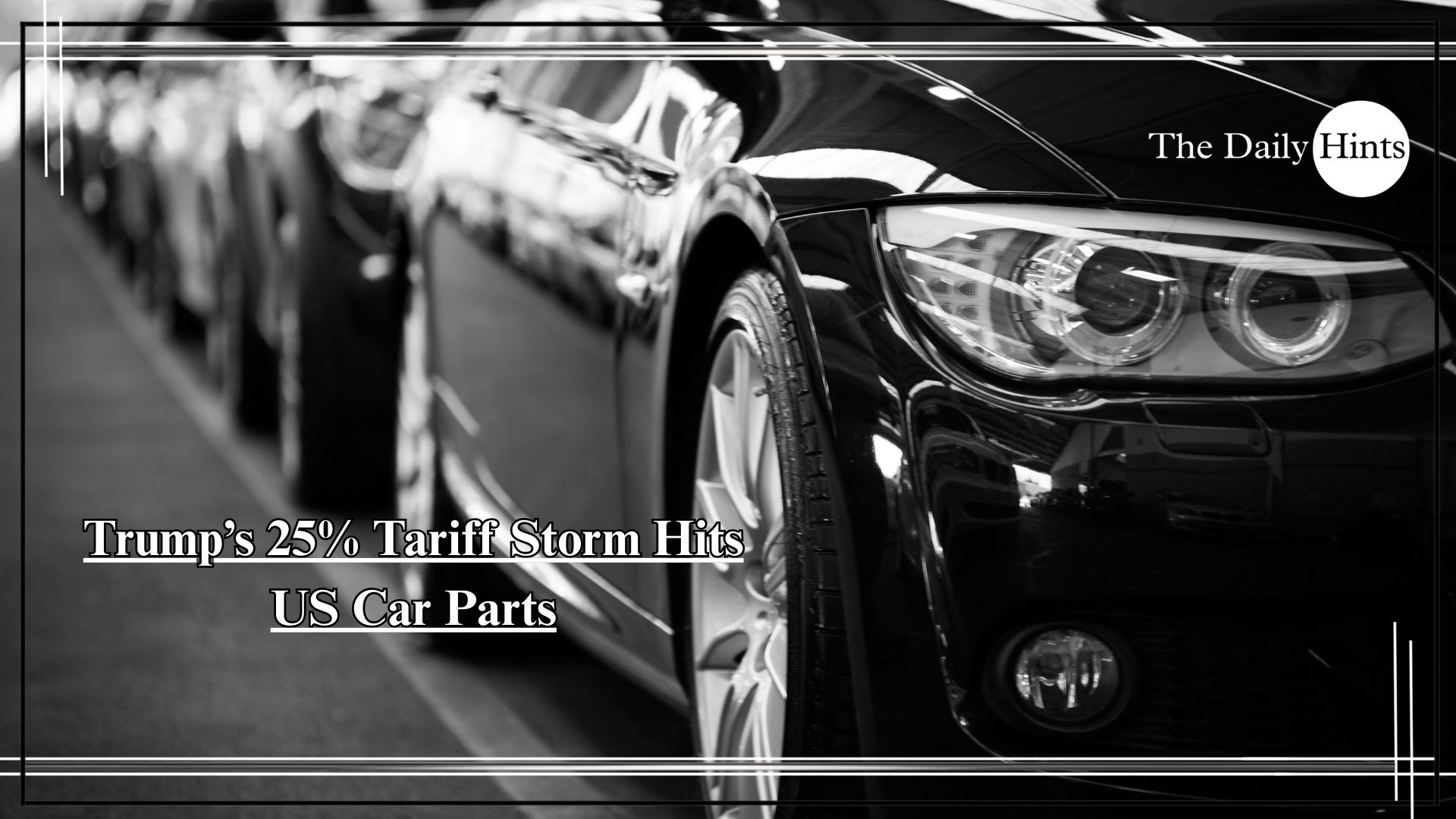Trump’s 25% Tariff Storm Hits US Car Parts: Prices Soar, Industry Shakes in 2025

- The Daily Hints
- 03 May, 2025
On May 3rd, 2025 a 25% tariff on car parts entering the US including engines and transmissions came into force rattling the automotive industry. Despite recent adjustments by President Trump, the new duties are set to increase production costs, push vehicle prices higher and reshape manufacturing strategies.
Details & Context
The US automotive industry is facing a seismic shift as a 25% tariff on imported car parts, such as engines and transmissions, took effect on May 3rd, 2025. This follows a similar 25% tariff on imported cars implemented in April, part of President Trump’s strategy to boost domestic manufacturing. Initially announced in March, these tariffs sent shockwaves through the industry, prompting automakers to warn of higher prices and disrupted supply chains. Trump recently softened the policy, offering exemptions for parts from Mexico and Canada under the USMCA free trade agreement, a move analysts now believe may be permanent following updated customs instructions this week. Additionally, Trump signed measures to prevent tariff stacking and introduced a two-year system allowing automakers to reduce duties on foreign parts used in US-assembled vehicles by up to 15% in the first year and 10% in the second.
Sponsored by: TR Textile (Premium Quality and Branded Shirt, Punjabi, Kurta, Blazer, Sherwani Manufacturer)
Despite these adjustments, the tariffs are already impacting major players. General Motors (GM) reported a sales surge in April, with double-digit growth alongside Ford, as consumers rushed to buy before price hikes. However, GM also projected $5 billion in new costs for 2025 including $2 billion tied to cars made in South Korea and exported to the US. Stellantis, the maker of Jeep, Fiat and Chrysler withdrew its financial guidance for the year, citing “extreme uncertainties.” Nearly half of the vehicles sold in the US in 2024 were imported, making the tariffs a significant challenge for an industry reliant on global supply chains built over decades of free trade with Canada and Mexico.
Google Trends data shows spiking searches for “Trump car tariffs 2025,” “US auto industry tariffs,” and “car price increase 2025,” reflecting consumer and industry concern. Posts on X reveal frustration, with users noting, “These tariffs are just going to make cars unaffordable for the average American,” while others support the push for US manufacturing, stating, “It’s about time we bring jobs back home.”
Quotes
· “The changes that have come in the last couple of days are going to make it easier ... but even so, it’s still a dramatic change to the market,” said Stephanie Brinley, principal automotive analyst at S&P Global Mobility, on May 3rd, 2025.
· “We remain subject to extreme uncertainties,” Stellantis CFO Doug Ostermann told analysts this week, highlighting the industry’s turmoil.
· “If I’m going to make a multi-billion dollar decision... I wouldn’t do it in a market that is this unstable,” said Art Wheaton, director of Labour Studies at Cornell University on the reluctance to build new factories.
Additional Information
The tariffs are part of Trump’s broader trade agenda which includes negotiations with key auto industry partners like South Korea and Japan. GM has already expanded truck production by 50,000 units at its Fort Wayne, Indiana plant while cutting output in Canada. Mercedes is exploring increased production at its Alabama facility, though experts like Wheaton caution that major investments in new factories are unlikely given the unstable market. The administration’s recent measures, such as preventing tariff stacking, aim to ease the burden but Chinese parts remain heavily targeted, facing tariffs of at least 145%. This has disrupted plans for companies like Tesla which suspended shipments of Chinese components for its Cybercab and Semi trucks, according to Reuters.
The US auto market saw a sales boom in March with 1.59 million units sold, the highest in four years, as consumers pre-empted price increases. However, executives now expect a 1% price rise in 2025, reversing earlier forecasts of price declines. Social media discussions on platforms like X highlight growing consumer anxiety over affordability with hashtags like #TrumpTariffs and #CarPriceHike trending as users debate the policy’s impact.
Read More: Albanese’s Epic Comeback: Labour’s Landslide Victory Shocks Australia in 2025 Election
Impact Analysis
The 25% tariffs on car parts are poised to reshape the US auto industry. Higher production costs will likely lead to increased vehicle prices, potentially making cars less affordable for consumers already grappling with economic pressures. GM’s projected $5 billion cost increase signals the scale of the challenge, while Stellantis’ withdrawal of financial guidance underscores the uncertainty. For manufacturers, the push to localise production may create jobs in the US but it could also strain global supply chains, reducing output in Canada, Mexico and Asia. Analysts predict that consumers may shift toward used vehicles, driving up demand and prices in that market.
Small businesses, such as auto repair shops, may also feel the pinch as imported parts become costlier, potentially leading to higher repair bills. On the flip side, the tariffs could encourage long-term investment in US manufacturing, aligning with Trump’s goal of boosting domestic industry. However, the immediate economic impact remains uncertain, with experts warning that the full effects of the tariffs are yet to be felt. Posts on X reflect a divided sentiment, with some users arguing, “This will kill the auto industry,” while others believe, “It’s a necessary step to protect American workers.”
The 25% tariffs on car parts entering the US, effective May 3rd, 2025 mark a pivotal moment for the automotive industry. While Trump’s recent adjustments offer some relief, the new duties are set to drive up costs, raise consumer prices, and force manufacturers to rethink global supply chains. As the industry navigates this turbulent landscape, the coming months will reveal the true economic fallout of these policies. Stay tuned for updates on this evolving story.
Call to Action (CTA)
For the latest on Trump’s tariffs and their impact on the US auto industry, follow and share The Daily Hints on X and social media. Join the conversation and stay informed.!
From district to city, country, international, entertainment to sports, science to technology and all other news updates, join our news portal The Daily Hints.
Leave a Reply
Your email address will not be published. Required fields are marked *



.jpg)

.jpg)
.jpg)
.jpg)
.jpg)
.jpg)
.jpg)